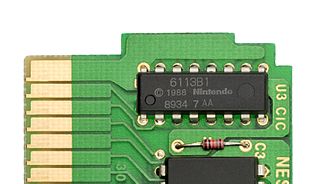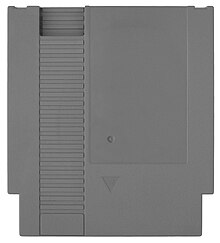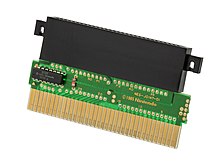
The Super Nintendo Entertainment System, commonly shortened to Super Nintendo, Super NES or SNES, is a 16-bit home video game console developed by Nintendo that was released in 1990 in Japan and South Korea, 1991 in North America, 1992 in Europe and Oceania and 1993 in South America. In Japan, it is called the Super Famicom (SFC). In South Korea, it is called the Super Comboy and was distributed by Hyundai Electronics. The system was released in Brazil on August 30, 1993, by Playtronic. Although each version is essentially the same, several forms of regional lockout prevent cartridges for one version from being used in other versions.

The Family Computer Disk System, commonly shortened to the Famicom Disk System, or just Disk System, is a peripheral for Nintendo's Family Computer home video game console, released only in Japan on February 21, 1986. It uses proprietary floppy disks called "Disk Cards" for cheaper data storage and it adds a new high-fidelity sound channel for supporting Disk System games.
Game Genie is a line of video game cheat cartridges originally designed by Codemasters, sold by Camerica and Galoob. The first device in the series was released in 1990 for the Nintendo Entertainment System, with subsequent devices released for the Super NES, Game Boy, Genesis, and Game Gear. All Game Genie devices temporarily modify game data, allowing the player to do things unintended by developers such as, depending on the game, cheating, manipulating various aspects of games, and accessing unused assets and functions. Five million units of the original Game Genie products were sold worldwide, and most video game console emulators for the platforms it was on feature Game Genie code support. Emulators that have Game Genie support also allow a near-unlimited number of codes to be entered whereas the actual products have an upper and lower limit, between three and six codes.

The NES Zapper, also known as the Video Shooting Series light gun in Japan, is an electronic light gun accessory for the Nintendo Entertainment System (NES) and the Japanese Famicom. It was released in Japan for the Famicom on February 18, 1984, and launched alongside the NES in North America in October 1985.

R.O.B. is a toy robot accessory for the Nintendo Entertainment System (NES). It was launched in July 1985 as the Family Computer Robot in Japan, and October 1985 as R.O.B. in North America. Its short lifespan yielded only two games in the Robot Series: Gyromite and Stack-Up.
In video gaming, famiclone is a term used to refer to a hardware clone of the Nintendo Entertainment System (NES), known in Japan as the Family Computer or Famicom. They are designed to replicate the workings of, and play games designed for, the NES and Famicom. Hundreds of unauthorized clones and unlicensed game copies have been made available since the height of the NES popularity in the late 1980s. The technology employed in such clones has evolved over the years: while the earliest clones feature a printed circuit board containing custom or third party integrated circuits (ICs), more recent (post-1996) clones utilize single-chip designs, with a custom ASIC which simulates the functionality of the original hardware, and often includes one or more on-board games. Most devices originate in China and Taiwan, and less commonly South Korea. Outside China and Taiwan, they are mostly widespread across emerging markets of developing countries.

Multi-memory controllers or memory management controllers (MMC) are different kinds of special chips designed by various video game developers for use in Nintendo Entertainment System (NES) cartridges. These chips extend the capabilities of the original console and make it possible to create NES games with features the original console cannot offer alone. The basic NES hardware supports only 40KB of ROM total, up to 32KB PRG and 8KB CHR, thus only a single tile and sprite table are possible. This limit was rapidly reached within the Famicom's first two years on the market and game developers began requesting a way to expand the console's capabilities.

The Super 8, also sold under the title Tri-star or Tristar, is an unlicensed video game peripheral released in 1995 for the Super Nintendo Entertainment System designed to allow the system to run games developed for the Nintendo Entertainment System. The Super 8 utilized an NES-on-a-chip integrated circuit to duplicate the functionality of the original NES hardware, and connected to the SNES's own cartridge slot.

Home Entertainment Suppliers Pty. Ltd. is an Australian company that distributes computer games and gaming equipment. HES' offices are based in Riverwood, Sydney. HES's founder and managing director is Sebastian Giompaolo.

Micro Genius is a brand name used for Famicom clone consoles marketed in several countries around the world, particularly in areas where Nintendo consoles were not readily available, including the Middle East, Southeast Asia, South America, Eastern Europe, South Africa and East Asian countries excluding Japan and South Korea. The name was initially and most famously used by TXC Corporation for its range of Taiwanese-made Famicom clones, software and accessories, but later passed to other companies and remains in use today on rebranded Chinese Famicom clones and LCD games.

A ROM cartridge, usually referred to in context simply as a cartridge, cart, or card, is a replaceable part designed to be connected to a consumer electronics device such as a home computer, video game console or, to a lesser extent, electronic musical instruments.

Final Fantasy VII is an unlicensed "Shanzhai" demake of SquareSoft's role-playing video game Final Fantasy VII, originally released for PlayStation in 1997. The two-dimensional "port" was developed and published by Chinese company Shenzhen Nanjing Technology for Subor, a Famiclone. The cartridge itself is unique, as it is structurally different from licensed Famicom cartridges in terms of hardware and programming.

The Nintendo Entertainment System (NES) is an 8-bit home video game console produced by Nintendo. It was first released in Japan on 15 July 1983 as the Family Computer (Famicom). It was then released in American test markets on 18 October 1985 as the redesigned NES, and fully launched in the United States the following year. The NES was distributed in Europe, Australia, and parts of Asia throughout the 1980s under various names. As a third generation console, it primarily competed with Sega's Master System and the Atari 2600.

The Checking Integrated Circuit (CIC) is a lockout chip designed by Nintendo for the Nintendo Entertainment System (NES) video game console in 1985; the chip is part of a system known as 10NES, in which a key is used by the lock to both check if the game is authentic, and if the game is the same region as the console.

Nintendo 64 Game Pak is the brand name of the ROM cartridges that store game data for the Nintendo 64. As with Nintendo's previous consoles, the Game Pak's design strategy was intended to achieve maximal read speed and lower console manufacturing costs through not integrating a mechanical drive, with a drawback of lower per dollar storage capacity compared to a disk. From the console's first year from late 1996 through 1997, Game Pak sizes were 4 to 12 megabytes with a typical third party retail price of US$75.99, then available in 32 megabytes in 1998, and finally 64 megabytes from 1999 onwards.

The Super Nintendo Entertainment System Game Pak is the system's default ROM cartridge medium. It is called Game Pak in most Western regions, and Cassette in Japan and parts of Latin America. While the Super NES can address 128 Megabits, only 117.75 Megabits are actually available for cartridge use. A fairly normal mapping can easily address up to 95 Megabit of ROM data with 8 Megabits of battery-backed RAM. However, most available memory access controllers only support mappings of up to 32 Megabits. The largest games released contain 48 Megabits of ROM data, while the smallest games contain 2 Megabits.

The Nintendo Entertainment System (NES), an 8-bit third-generation home video game console produced by Nintendo, had numerous model variants produced throughout its lifetime. It was originally released in 1983 as the Family Computer in Japan, with design work led by Masayuki Uemura. Nintendo intentionally redesigned it as the NES in North America in an attempt to avoid the stigma of video game consoles lingering from the video game crash the same year; while it was initially conceptualized as a home computer, it was ultimately modeled after a videocassette recorder (VCR) for its debut there in 1985. Nintendo subsequently exported the NES to Europe and Oceania via local distributors.
















